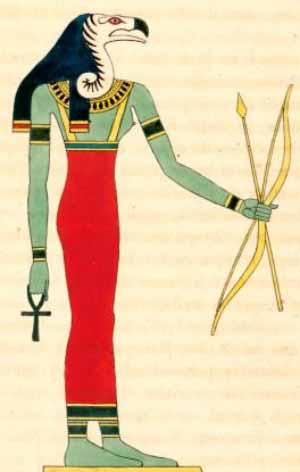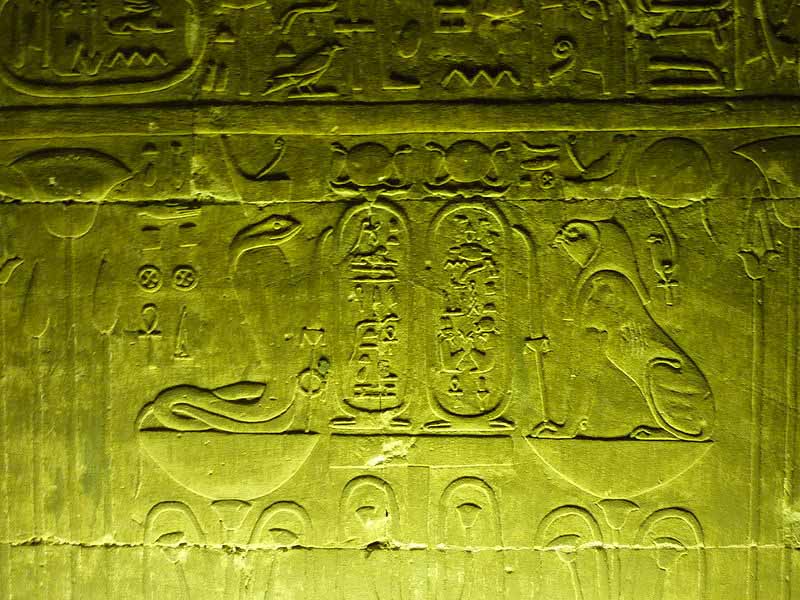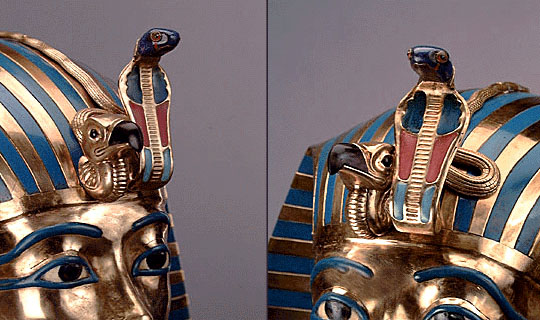

In Egyptian mythology, Wadjet, or the Green One (also spelled Wadjit, Wedjet, Uadjet or Ua Zit and in Greek, Udjo, Uto, Edjo, and Buto among other names), was originally the ancient local goddess of the city of Dep (Buto), which became part of the city that the Egyptians named Per-Wadjet, House of Wadjet, and the Greeks called Buto (Desouk now), a city that was an important site in the Predynastic era of Ancient Egypt and the cultural developments of the Paleolithic.
She was said to be the patron and protector of Lower Egypt and upon unification with Upper Egypt, the joint protector and patron of all of Egypt with the "goddess" of Upper Egypt. The image of Wadjet with the sun disk is called the uraeus, and it was the emblem on the crown of the rulers of Lower Egypt. She was also the protector of kings and of women in childbirth.
As the patron goddess, she was associated with the land and depicted as a snake-headed woman or a snake - usually an Egyptian cobra, a poisonous snake common to the region; sometimes she was depicted as a woman with two snake heads and, at other times, a snake with a woman's head. Her oracle was in the renowned temple in Per-Wadjet that was dedicated to her worship and gave the city its name. This oracle may have been the source for the oracular tradition that spread to Greece from Egypt.
The Going Forth of Wadjet was celebrated on December 25 with chants and songs. An annual festival held in the city celebrated Wadjet on April 21. Other important dates for special worship of her were June 21, the Summer Solstice, and March 14. She also was assigned the fifth hour of the fifth day of the moon.
The name Wadjet is derived from the term for the symbol of her domain, Lower Egypt, the papyrus.
Her name mean "papyrus-colored one", as wadj is the ancient Egyptian word for the color green (in reference to the color of the papyrus plant) and the et is an indication of her gender. Its hieroglyphs differ from those of the Green Crown (Red Crown) of Lower Egypt only by the determinative, which in the case of the crown was a picture of the Green Crown and, in the case of the goddess, a rearing cobra.
Eventually, Wadjet was claimed as the patron goddess and protector of the whole of Lower Egypt and became associated with Nekhbet, depicted as a white vulture, who held the same title in Upper Egypt. When the two parts of Egypt were joined together, there was no merger of the deities as often occurred, both beliefs were retained and became known, euphemistically, as the two ladies, who were the protectors of unified Egypt. After the unification the image of Nekhbet joined Wadjet on the crown, thereafter shown as part of the uraeus.
The ancient Egyptian word Wedjat signifies blue and green. It is also the name for the well known Eye of the Moon, which later became the Eye of Horus and the Eye of Ra as additional sun deities arose. Indeed, in later times, she was often depicted simply as a woman with a snake's head, or as a woman wearing the uraeus. The uraeus originally had been her body alone, which wrapped around or was coiled upon the head of the pharaoh or another deity
Depicted as an Egyptian cobra she became confused with Renenutet, whose identity eventually merged with hers. As patron and protector, later Wadjet often was shown coiled upon the head of Ra, who much later became the Egyptian chief deity; in order to act as his protection, this image of her became the uraeus symbol used on the royal crowns as well.
Another early depiction of Wadjet is as a cobra entwined around a papyrus stem, beginning in the Predynastic era (prior to 3100 B.C.) and it is thought to be the first image that shows a snake entwined around a staff symbol. This is a sacred image that appeared repeatedly in the later images and myths of cultures surrounding the Mediterranean Sea, called the caduceus, which may have had separate origins.
Her image also rears up from the staff of the "flag" poles that are used to indicate deities, as seen in the hieroglyph for uraeus above and for goddess in other places.
An interpretation of the Milky Way was that it was the primal snake, Wadjet, the protector of Egypt. In this interpretation she was closely associated with Hathor and other early deities among the various aspects of the great mother goddess, including Mut and Naunet. The association with Hathor brought her son Horus into association also. The cult of Ra absorbed most of Horus's traits and included the protective eye of Wadjet that had shown her association with Hathor.
When identified as the protector of Ra, who was also a sun deity associated with heat and fire, she was sometimes said to be able to send fire onto those who might attack, just as the cobra spits poison into the eyes of its enemies. In this role she was called the Lady of Flame.
She later became identified with the war goddess of Lower Egypt, Bast, who acted as another figure symbolic of the nation, consequently becoming Wadjet-Bast. In this role, since Bast was a lioness, Wadjet-Bast was often depicted with a lioness head.
After Lower Egypt had been conquered by Upper Egypt and they were unified, the lioness goddess of Upper Egypt, Sekhmet, was seen as the more powerful of the two warrior goddesses. It was Sekhmet who was seen as the Avenger of Wrongs, and the Scarlet Lady, a reference to blood, as the one with bloodlust. She is depicted with the solar disk and Wadjet, however.
Eventually, Wadjet's position as patron led to her being identified as the more powerful goddess Mut, whose cult had come to the fore in conjunction with rise of the cult of Amun, and eventually being absorbed into her as the Mut-Wadjet-Bast triad.
When the pairing of deities occurred in later Egyptian myths, since she was linked to the land, after the unification of Lower and Upper Egypt she came to be thought of as the wife of Hapy, a deity of the Nile, which flowed through the land.
Wadjet is not to be confused with the Egyptian demon Apep, who is also represented as a snake in Egyptian mythology.

Two images of Wadjet appear on this carved wall in the Hatshepsut Temple at Luxor

Wadjet was closely associated in the Egyptian pantheon with Bast, the fierce goddess depicted as a lioness warrior and protector, as the sun goddess whose eye later became the eye of Horus, the eye of Ra, and as the Lady of Flame. The hieroglyph for her eye is shown below; sometimes two are shown in the sky of religious images. Per-Wadjet also contained a sanctuary of Horus, the child of the sun deity who would be interpreted to represent the pharaoh. Much later, Wadjet became associated with Isis as well as with many other deities.
In the relief shown to the right, which is on the wall of the Hatshepsut Temple at Luxor, there are two images of Wadjet: one of her as the uraeus sun disk with her head through an ankh and another where she precedes a Horus hawk wearing the double crown of united Egypt, representing the pharaoh whom she protects.

Often shown as a rearing cobra, she was a protector of the pharaoh, ready to strike and kill his enemies. She was also depicted as a woman-headed cobra, a winged cobra, a lion-headed woman, or a woman wearing the red crown of Lower Egypt. She was often shown together with Nekhbet who was in an identical form - as a snake or woman - or paired together with Wadjet as a snake and Nekhbet as a vulture.
Wadjet is primarily a snake-headed protector of Lower Egypt - the delta region. However, the ancient people of northern area worshiped Wadjet as a vulture Goddess. Wadjet was revered as the goddess of childbirth, and protector of children, and in later years she became the protector of kings. WadjetÕs role was often seen as a forceful defender, while her sister, Nekhebet, was seen as the motherly defender. This contrast provided the counterpoint seen in many of the Egyptian deities. The symbol of justice, time, heaven and hell, Wadjet is one of the oldest Egyptian goddesses.

Often depicted as a cobra, or as the head of the cobra, Wadjet can be seen rearing from the forehead of the rulers as the Ureus. Evidence of her protection is most notable upon the funerary mask of Tutankhamen. Occasionally, she has been shown in the guise of her "eye of divine vengeance" role, as a lioness. In later years, the royal crowns were often decorated with two or more depictions of cobras in deference to her role as protector.
While Wadjet was sometimes depicted as the lioness-headed goddess, she was often seen in the image of a mongoose, represented on the funeral urns of ancient Egypt. The mongoose was revered as her sacred animal. Along with the shrew mouse, they were mummified and entombed in statuettes of the goddess. It is believed that the mongoose, and the shrew mouse were representative of the day and night cycle. The mongoose representing daylight, and the nocturnal shrew mouse representing night.
Many Egyptian deities were associated with specific hours, days, and months, and Wadjet was no different. Her time was considered to be the fifth hour of the fifth day of the month, or lunar cycle. Interestingly enough, December 25th, on the Egyptian calendar, was considered to be the "going forth of the Goddess," while April 21st was her feast day. The many days when Wadjet is honored culminate during her month, Epipi, the harvest or summer month. This corresponds to mid-May through mid-June on the Gregorian calendar.
Legend has it that Wadjet was the daughter of Atum, the first god of the Universe. He created her as his eye. Her purpose was to search the Universe for his lost sons, Tefnut and Shu. Wadjet did find his sons, and Atum was so happy to see them that he cried. It is said that those tears made humans. As a reward, Atum placed Wadjet upon his head in the form of a cobra. There she would be feared and respected by all the gods and men.
- The Book of the Dead
She became a goddess of heat and fire and this enhanced her role as a protector goddess - with such fierce powers she could use not only poison but flames against the enemies of the pharaoh. Along with her link to this power, she became connected with the 'Eye of Ra', and was thus also connected to the other goddesses who took this title - Bast, Tefnut, Sekhmet, Hathor, Isis, and her 'twin' in duality, Nekhbet. Along with this form, she took the form of a lioness, as did many of the other 'Eye of Ra' goddesses. In this form she wore the solar disk of Ra - linking her to the sun - with the uraeus (the rearing cobra) as her headdress.
In the story of Horus and Set, when Horus is trying to find and rout the followers of Set, Horus pursued them in the form of a burning, winged disk, attended by both Nekhbet and Wadjet as crowned snakes, one on each side of him. This, too, linked her with the pharaoh, as the Egyptians believed that the pharaoh was the living Horus. She not only protected Horus in his fight, but she also protected the pharaoh from childhood until death. As protector, she was known as "The August One, the Mighty One".
Her main sacred animal was the cobra, but by the Late Period she was assigned yet another sacred animal - the ichneumon, a mongoose-like creature known for its ability to kill snakes and crush crocodile eggs. There are examples of a Late Period coffin of an ichneumon with an image of Wadjet seated on top of the coffin:
The ichneumon became a sacred animal of the lion-headed goddess Wadjet as a result of religious developments of the Late Period, when local traditions were frequently linked, and new mythic associations were established. The deities of the Delta cities of Khem (Letopolis) and Per-Wadjet became associated through myth, and the ichneumon - a sacred animal of Horus of Khem - became a sacred animal of the goddess Wadjet of Per-Wadjet.
Unlike other sacred animals ... ichneumons were occasionally placed in statuettes of the lion-headed goddess Wadjet. The most common type depicts the goddess seated on a throne, usually crowned by the uraeus - the rearing fire-spewing cobra at the king's brow, with which Wadjet was identified. The throne, or a base attached to it, which was usually hollow, contained the mummified ichneumon.
- Coffin of an Ichneumon, The Israel Museum
By dynastic times, Wadjet was more a personification than an actual goddess and so she was often used (with Nekhbet) as a heraldic device around the sun disk or the royal name and were part of the royal insignia. The earliest found representation of the nebty title was in the reign of Anedjib, a pharaoh of the 1st Dynasty. From the 18th Dynasty onwards, she began to be represented as protecting the royal women in the form of one of the twin uraei on the headdresses of the queens.
Isis retreated to the papyrus swamps after she has conceived her child, and she remained hidden in them until her months were fulfilled, when she brought forth Horus, who afterwards became the "avenger of his father"; Set never succeeded in finding her hiding place, because the great goddess had found some means whereby she caused the papyrus and other plants to screen her from his view, and the goddess Wadjet visited her and helped her retreat.
Yet Wadjet also had a nurturing side, as did Nekhbet. Wadjet was believed to have helped Isis nurse the young Horus as well as help hide them in the swampy delta area of the Nile - as the goddess of Lower Egypt, she was also a personification of the papyrus-filled delta - and helped to keep the two safe from Set, who wanted to kill Horus and claim the throne for himself.
Another link to her more gentle side was her link with nature - in the Pyramid Texts it said that the papyrus plant emerged from her, and that she was connected to the forces of growth. It was also believed that she created the papyrus swamps herself.
Wadjet was thought to be the wife of Hapi, in his Lower Egyptian aspect. She was also linked to Set in his role of god of Lower Egypt. She was also believed to be the wife of Ptah and mother of Nefertem (in place of Sekhmet or Bast), by the people of Per-Wadjet, probably because of her later form of a lioness. She was the goddess of the eleventh month of the Egyptian calendar, by Greek times known as Epipi.
She was worshiped at the Temple of Wadjet, which was referenced to by the name 'Pe-Dep', in the Pyramid Texts, and was by that time believed to be both very old and famous. It was believed that even at early times, the Egyptians linked Wadjet with Isis and the god Horus, and that both of these deities were also worshiped in the town of Per-Wadjet, which was divided into two parts - Pe and Dep:
- The Gods of the Egyptians, E. A. Wallis Budge
From local goddess of a predynastic town to the goddess of Lower Egypt, Wadjet became one of the symbols of Egypt. From the personal protector of the pharaoh and she who bestowed the red crown to the pharaoh, she also became the symbol of rulership. And from the goddess of papyrus and the Delta to the 'Eye of Ra', she took on the role of protector of the ruler. She was worshiped as a goddess as well as being the personification of the north, the cobra goddess who was one half of a manifestation of the idea of duality that was a basis of Ma'at "which the goddess Wadjet worketh". Not only was she a goddess, but she was one part of the land of Egypt itself.
In the modern world, Wadjet has once again surfaced as the goddess of an intriguing game that allows the players to explore ancient Egypt. The game is introduced, 'Your destination is the Valley of the Kings where you will experience a world of burning desert heat and blinding sandstorms. You will know the intrigue, the secrets, and the dangers that lie in every step through the dark corridors of the ancient tombs, as you search for the stolen treasures of the Pharaoh. But beware, the cobra goddess Wadjet has guarded the royal kings and their treasures for over 3000 years. She awaits your intrusion.' This interpretation of the goddess holds true to the images we see of her throughout ancient history.
- Gods of the Egyptians, The (Studies in Egyptian Mythology) Budge, E. A. Wallis 1969